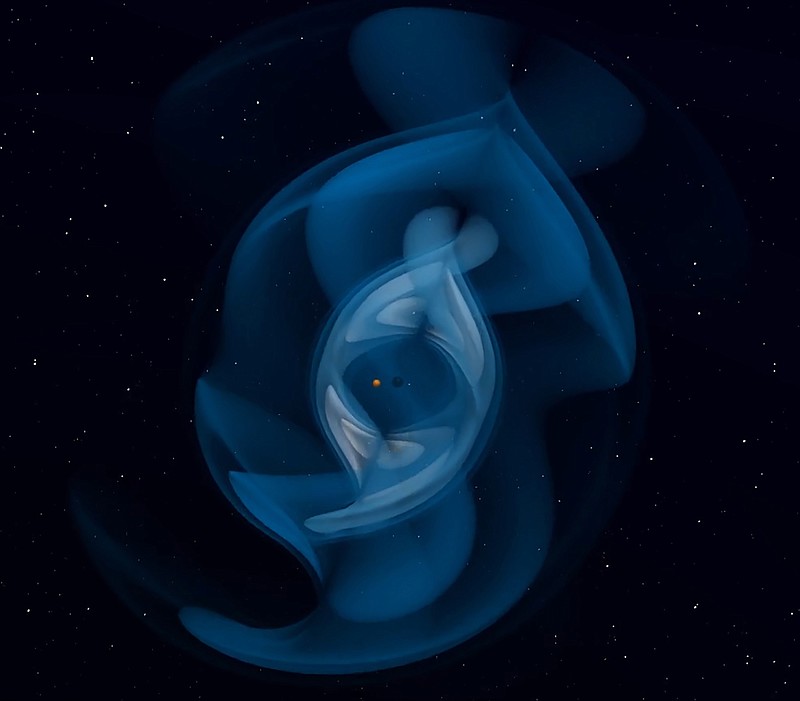In January 2020, astronomers definitively observed, for the first time, a black hole swallowing a dead star, like a raven devouring roadkill.
Then 10 days later, they saw the same act of scavenging happen again in a different, distant sector of the cosmos.
Those triumphs, reported in a paper published in Astrophysical Journal Letters on June 29, are the latest in the still nascent field of gravitational astronomy, which is detecting the literal stretching and scrunching of space-time caused by some of the most cataclysmic events in the universe.
"It's the first time that we've actually been able to detect a neutron star and a black hole colliding with each other anywhere in the universe," said Patrick Brady, a professor of physics at the University of Wisconsin-Milwaukee who serves as the spokesman for the LIGO Scientific Collaboration.
Astronomers had suspected that pairings of black holes and neutron stars did exist. But until they saw these collisions, these hunches were not confirmed. The discovery helps fill in knowledge about the binary star systems that populate the universe, while also raising questions about why astronomers have never seen such a pair in our Milky Way galaxy.
For more than 20 years, LIGO — Laser Interferometer Gravitational-Wave Observatory — has been searching for these rumblings, a prediction of Einstein's theory of general relativity. For years, the laser beams in the observatory, one in Hanford, Wash., the other in Livingston, La., detected nothing.
Then in September 2015, both locations of LIGO observed the long-sought ringing of gravitation waves.
Those waves were generated by a collision of two stellar-size black holes — punctures in the space-time fabric created when the most massive stars explode as supernovas at the end of their lives. The two black holes orbited each other, swinging around each other closer and closer until they finally merged into one.
Two years later, LIGO detected the collision of two neutron stars — the burnt-out remnants of stars more massive than the sun but not large enough to collapse into black holes. Such collisions create most of the gold and silver in the universe.
With the help of VIRGO, a similar but smaller European gravitational wave observatory in Italy, astronomers were able to pinpoint the part of the sky where the explosion occurred, and a series of telescopes were then able to detect particles of light, from radio waves to X-rays, emanating from that fireball.
Astronomers had long expected to find a neutron star orbiting a black hole, but in nearly half a century of searches of our Milky Way galaxy, they never found one. "So in effect, we've had this mystery question," Brady said. "Why have we not seen a neutron star-black hole system?"
The new gravitational wave observations prove that these pairs exist, albeit far away from the Milky Way. The first detection of a neutron star merging with a black hole occurred Jan. 5, 2020. The facility in Hanford was temporarily offline, so the signal was detected in Livingston. The VIRGO detector also picked up a faint signal, providing corroboration.
By studying changes in the frequency of the gravitational waves, astrophysicists were able to determine the properties of the objects colliding in the distant reaches of the universe.
The black hole was about nine times the mass of the sun; the neutron star was smaller, but still about twice the mass of the star our world orbits. The collision occurred at a distance of about 900 million light-years from Earth.
On Jan. 15, 2020, the Hanford site was back up, and all three instruments detected the second collision of a black hole and a neutron star. This one was farther away. Both objects were a bit lighter. The neutron star was about 1.5 times the mass of the sun, and the black hole was about six times the mass of the sun.
Unlike the 2017 collision of two neutron stars, telescopes were unable to spot any particles of light from the explosions. The black holes appear to have been big enough to swallow the neutron stars quickly, reducing the chances of detectable emissions.
